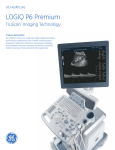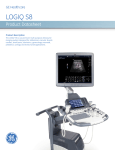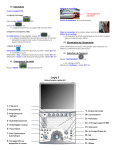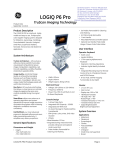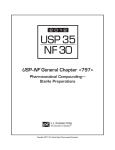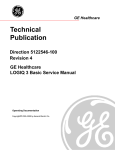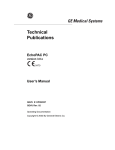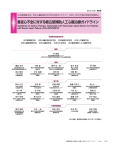Download 8 - NEW AND Refurbished Ultrasound Equipment
Transcript
GE Healthcare LOGIQ P6 TruScan Imaging Technology Product Description The LOGIQTM P6 is a premium performance, highly mobile and easy to use multipurpose imaging system designed for obstetrics, gynecology, cardiology, musculoskeletal, vascular, urological, small parts, superficial, pediatric, neonatal, transcranial, and abdominal applications. System Architecture TruScanTM Architecture our exclusive, software-intensive ultrasound imaging platform that gives you unsurpassed computational power, image-manipulation capability, workflow flexibility and product upgrade-ability, via software or hardware. • TruAccess - is the GE-exclusive, raw-data processing technology that will change the future of ultrasound imaging. By accessing raw data, TruScan achieves excellent image quality and ensures unsurpassed today’s image management tomorrow. • SmartScan - utilizes new advances in operating algorithms and system operations to improve image acquisition and patient throughput while increasing diagnostic confidence and exam consistency. • ComfortScan - our most advanced ergonomic design ever, helps maximize productivity and simplify every exam you perform. LOGIQ P6 Page 1 of 14 General Specification Dimensions and Weight • Height: - Maximum 1470 - Minimum 1250 • Width: 43cm • Depth: 64cm • Weight: approx. 80 kg (176 lb.) Electrical Power • Voltage: 100-120Vac or 220-240Vac • Frequency: 50/60 Hz • Power: Max. 750 VA with Built-in and On-Board Peripherals • Maximum Thermal Output: 2200 BTU/hr. Console Design • • • • • • • • • 3 Active Probe Ports Integrated HDD (Capacity : 80GB) Integrated DVD-R/W Drive On-board Storage for Peripherals (max 3 peripherals) - B/W-printer, color printer, DVD video recorder Wheels - Wheel diameter: 12.5cm - Integrated locking mechanism that provides rolling lock and optional caster swivel lock Probe Holders, Removable for Cleaning and Washing Gel Holder, Removable for Cleaning and Washing Air Filters, Easily Removable Front Handle Monitor • 17 inch TFT LCD depending on region • XGA Format: - Display size: 1024 x 768 • Tilt/Rotate/Translate - Tilt Angle +40°- -90° - Rotate Angle: +/-90° - Translate Horizontal +/- 442 mm - Translate Vertical 160 mm • Flexible Arm for Monitor Translation in X,Y, and Z axis • Digital Brightness/Dim Bright/Contrast Adjustment System Overview Applications • • • • • • • • • • • • • Abdominal Obstetrical Gynecological Cardiac Musculoskeletal Vascular Urological Small Parts and Superficial Breast Pediatric and Neonatal Transcranial Endocavitary Transesophageal Scanning Methods • • • • Electronic Sector Electronic Convex Electronic Linear Mechanical Volume Sweep User Interface Operator Keyboard Width: 43cm Height: 84 - 90cm Alphanumeric Keyboard Ergonomic Hard Key Operations Indicator Lights Identify Activated Keys Integrated Recording Keys for Remote Control of Up to 2 Peripheral Devices and DICOM Devices • 8 TGC Pods, with Re-mapping Functionality at Any Depth • • • • • • LOGIQ P6 Transducer Types • • • • • • • Sector Phased Array Convex Array Microconvex Array Linear Array Single CW (Pencil) Probes Bi-plane Microconvex Array 4D Volume Probes Operating Modes • • • • • • Power Doppler Imaging (PDI) with Directional Map • PW Doppler with High PRF • M-Color Flow Mode • Anatomical M-Color Mode (option) • B-Flow Mode (option) • Coded Contrast Imaging (option) • CW Doppler Mode (option) • 3D/4D Volume Modes (option) • 3D Static • 4D Real Time System Standard Features • Hard Disk for image storage • Without compression: • Raw DICOM: > 14500 images • DICOM: - Image Only: > 16,000 images • <1000 Frames (60 sec) CINE Memory (256MB) • Real-time Triplex Mode at any Depth and PRF • Automatic Optimization - Auto Tissue Optimization: ATO - Auto Spectrum Optimization: ASO - Auto Color Optimization: ACO • CHI, Coded Harmonic Imaging • PHI, Phase inversion Harmonics • Coded Excitation • SRI Speckle reduction imaging • CRI CrossBeam • Virtual Convex • Patient Information Database • Image Archive on Hard Drive and DVD • Easy Backup to Media for data security • TruAccess, Raw Data Processing and Analysis • Vascular Calcs • Cardiac Calcs • OB Calcs • Fetal Trending • Multi Gestational Calcs • Hip Dysplasia Calcs • Gynecological Calcs • Urological Calcs • Renal Calcs • Real-time Auto Doppler Calculations • On-board basic Reporting B-Mode Coded Harmonic Imaging M-Mode Anatomical M-Mode (option) Color Flow Mode (CFM) Page 2 of 14 System Options • • • • • • • • • • • • • • • • • Easy 3D Advanced 3D, with 3D Landscape DICOM 3.0 Connectivity LOGIQView B-Flow Coded Contrast Imaging Anatomical M-Mode Real Time 4D Report Designer (on-board reporting) ECG ECG Cable Steering CW/Single CW Assy 3-Pedal Foot Switch, with Programmable Functionality Rear Handle Drawer Probe Cable Hanger Urology Probe Holder • Colorized Image - Colorized B - Colorized M - Colorized PW - Colorized CW (option) • Time line Display - Independent Dual B/PW Display - Display Formats: Top/ Bottom or Side/ Side selectable Format Size: (able to switch after freeze) - Vertical: 1/3, ½, 2/3 - Horizontal: ¼, ½ - Full: Time line only - Update mode: timed based on sweep • Virtual Convex • CrossBeam Display Annotation Media & Peripheral Options • Integrated Mounting Kits and Remote Controls Provided for - B/W Digital thermal printer - Digital Color A6 Digital thermal printer - Digital Color A5 Digital thermal printer - DVD Video Recorder Display Modes • Simultaneous Capability - B/PW - B/CFM or PDI - B/M - B + CFM/M - Real-time Triplex Mode (B + CFM or PDI/PW) - Dual B (B/B) - Dual B + CFM or PDI • Selectable Alternating Modes - B/M - B/PW - B + CFM (PDI)/M - B + CFM (PDI)/PW - 3D – Mode (option) - 3D – Color Mode (option) - B + CW (option) • Multi Image Split Screen - Live and/or frozen - B + B/CFM or PDI - Independent Cine playback - Quad screen format • Zoom: Write/Read/Pan LOGIQ P6 • Institution/Hospital Name: 25 Characters • Date: 3 types selectable YY/MM/DD, MM/DD/YY, DD/MM/YY • Time: 2 types selectable 24 hours, 12 hours • Operator Identification • Patient Name: First, Last & Middle name each store 64 characters. Up to 64 total characters displayed • Patient Identification: 31 Characters • Gestational Age from LMP/EDC/GA/BBT • Power Output Readout - MI: Mechanical Index - TIS: Thermal Index Soft Tissue - TIC: Thermal Index Cranial (Bone) - TIB: Thermal Index Bone • System Status (real-time or frozen) • Probe Orientation Marker: Coincides with a probe orientation marking on the probe. • Image Preview • Gray/Color Bar • Cine Gauge • Measurement Summary Window • Measurement Results Window: presettable display location • Probe Type • Application Name • Imaging Parameters by Mode (current mode highlighted) - B/M-Mode Imaging Frequency Gain Edge Enhance Frame Averaging • • • • • • • • • • • • Gray Map Image Depth Dynamic Range Line Density % of Power Output - Color Flow Mode(Optional) Doppler Frequency Color Gain Line Density Frame Averaging % of Power Output PRF Wall Filter Spatial Filter Packet Size - PW-Mode Doppler Frequency Doppler Gain % of Power Output PRF Wall Filter Sample Volume Width Dynamic Range Sample Volume Depth Angle Correction Focal Zone Markers TGC Curve: On/Off Body Pattern: 106 types B Scale Markers: 2 types Depth/Width & Depth M Scale Markers: Time/Depth Image Management Menu: Menu, Delete, and Image Manager Image Palette Caps Lock: On/Off System Messages Display Trackball Functionality Status: Scroll, M&A (Measurement and Analysis), Position, Size, Scan Area Width and Tilt Biopsy Guide Line and Zone Heart Rate General System Parameter System Setup • Diagnostic Categories: 8 types, presettable Abd, Obst, Gyn, Card, Vasc, Urol, Small partsts, Pediatrics • User Programmable Preset Capability • Factory Default Preset Data • Languages: Chinese, Czech, Danish, Dutch, English, Finnish, French, German, Hungarian, Italian, Japanese, Norwegian, Polish, Russian, Spanish, Swedish • Operation Error Beep: Off, Low, Loud • Body Surface Area: 2 types Page 3 of 14 Oriental, Occidental • OB Report Format: 4 types Tokyo Univ., Osaka Univ., USA, Europe • EFBW: 8 types Tokyo Univ., Osaka Univ., USA and Europe (Shephard, Merz, Hadlock/Shephard, Williams, Brenner) • CUA/AUA for Hadlock • Body Pattern Copy to Active Side: On/Off • Colorized B/M/D: 6 types for each • Programmable Annotation Library: 24 annotations • Customized Common Home Position • Color Printer Memory: 3 types Single, Quad-Frm, Quad-Frmls • Menu Selection at New Patient: 2 types Patient Entry, Schedule • Sort Criteria for Schedule List: 2 types Date&Time, Name • Patient Name Format: 2 types Full Name, Last&First • Auto Deletion of Transferred Queue: Yes/No • Pre-settable Doppler Audio Volume • Measurement Clear Operation: 2 types Meas.-only, with-Comment • Display Unit Age: 5 types Year, Month, Week, Day, No display • System Boot Up: 90 sec • Probe Change: 5 sec Complete User Manual available on board through Help (F1) User Manual and Service Manual are included on CD with each system. A printed Manual is available upon request. CINE Memory/Image Memory • <1000 Frames (60 sec) with Standard CINE Memory (256 MB) depend on FOV, Scanning Lines etc. • CINE Gauge and CINE Image Number Display • CINE Review: Frame-by-frame, Loop • CINE Review Speed: 20 steps (10, 20, 30, 40, 50, 60, 70, 80, 90, 100, 150, 200, 300, 400, 500, 600, 700, 800, 900, 1000%) • Selectable CINE Sequence for CINE Review • Start and End Frame Selections for Loop Playback • Measurements, Calculations and Annotations on CINE Playback • Scrolling Timeline Memory LOGIQ P6 • Cine Capture Function • Pre-settable ECG Position • Adjustable ECG Gain Control Image Storage • On-board database of patient information from past exams • Storage Format: DICOM/Raw Data • DICOM Still Image Storage Size: • Gray Image: ~300K to ~1.3 MB • Color Image: ~900K to 1.9 MB • Multi-frame • Display Format: Full size, 4x4, and "thumbnails" • Live image and stored image side-byside display • CD-R storage: 650, 700 MB • Conversion to JPEG, AVI (SaveAs) and WMV (MPEGvue) file formats • Internal Hard Drive Image Storage: 25 GB • External USB 2.0 Hard Drive support for Import, Export, DICOM Read, SaveAs, MPEGVue and EZ Backup/EZMove • USB 2.0 Memory Stick support for SaveAs, USB QuickSave and MPEGVue • Network Storage support for Import, Export, DICOM Read, SaveAs, MPEGVue and USB QuickSave Connectivity • Ethernet Network Connection • USB serial data output (need a converter cable) • DICOM Support (option) - Verify - Print - Store - Modality Worklist - Multiframe - Storage Commitment - Modality Performed Procedure Step (MPPS) - Media Exchange - Off network/mobile storage queue - Query/Retrieve - Structure Reporting - Public SR Template - Media Store of SR - iLinqTM capability Physiological Input Panel (Option) • Physiological Input - ECG, 1 channel • Dual R-Trigger • Pre-settable ECG R Delay Time Scanning Parameters • Digital Beamformer • 14336 System Processing Channel Technology • Displayed Imaging Depth: 2 – 30 cm probe dependent • Minimum Depth of Field: 2 cm (Zoom and probe dependent) • Maximum Depth of Field: 30 cm (probe dependent) • Transmission Focus - 1 – 8 Focus Points Selectable (probe and application dependent) - Focal Zone Position, B-Mode 16 steps, CFM 64 steps • Continuous Dynamic Receive Focus/Aperture • Multi-Frequency/Wideband Technology • 256 Shades of Gray • Up to 197 dB Processing Dynamic Range • Adjustable Field of View (FOV) • Image Reverse: Right/Left • Image Rotation: 4 steps • Rotation: 0°, 90°, 180° and 270° B-Mode • B/M Acoustic Output: 0 – 100%, 2 % step • Image Reverse: On/Off • B Color: 8 types • Thermal Index: TIC, TIS, TIB • Softener: 4 steps • Focus Number: 8 steps • Focus Width: 3 types • Range Focus: On/Off • Compress: 0.5 – 1.5 dB, 0.1 dB step • Line Density: 4 steps • Noise Suppression: 6 steps • Frame Average: 6 steps • Max Frame rate > 800 f/s • Edge Enhance: 6 steps • Angle/Width (deg, mm): probe dependent, 10 – 170°, 2° step in case of E8CS probe • Gray Scale Map: 23 types • Gain: 0 – 98 dB, 2 dB step Page 4 of 14 • Dynamic Range: 30 – 120 dB, 3 dB step • Harmonic Start: On/Off default presettable • Virtual Convex: On/Off • Depth: 2 – 30 cm, 1 cm step (probe dependent) • Focus Depth: 91 steps default presettable • Rejection: 6 steps • Frequency: 3-4 steps (probe dependent) • Dual Beam: On/Off pre-settable • Steered Linear: +/- 15° • Auto Line Density: On/Off pre-settable Color Flow Mode • • • • • • • • • • • • • • • • • • • • • • • Base Line: 0 – 100 %, 10 % step Invert: On/Off Capture: 4 steps pre-settable CF/PDI Focus Depth: 10 – 100 %, 5 % step default pre-settable CF/PDI ACE: On/Off CF/PDI Acoustic Output: 0 – 100%, 10% step PW/CF/PDI Angle Steer: +/- 10°, 20° (linear probe) Packet Size: 5 -16, dependent on probe/applications Line Density: 5 steps Frame Average: 7 steps PRF: 300 Hz – 10400 Hz (probe dependent) Spatial Filter: 6 steps (application dependent) Gain: 0 – 40 dB, 0.5 dB step Wall Filter: 7 steps depend on probe Virtual Convex: On/Off Angle/Width (deg, mm): probe dependent CFM Window Size (depends on probe) • Convex 10° - 170° • Sector 10° - 90° • Linear 10 – 46mm CF/PDI Frequency: 2 steps Color Map: 13 types (probe dependent) • Velocity: 7 types • Velocity/Variance: 3 types • Additional: 3 types Color Threshold: 0 – 100 %, 5 % step Auto Line Density: On/Off pre-settable CFM/PWD Ratio: 1, 2, 4 Accumulation Mode: 8 steps LOGIQ P6 • Symmetrical Velocity Imaging for optimized 3D color images PDI-Mode • PDI Map: 13 types • CF/PDI Flash Suppression: 2 steps • CF/PDI Focus Depth: 11 steps default pre-settable • CF/PDI Acoustic Output: 0 – 100%, 10% step • PW/CF/PDI Angle Steer: +/- 10°,20° (linear probe) • Packet Size: 5 -16, dependent on probe/applications • Spatial Filter: 6 steps (probe dependent) • Frame Average: 7 steps • PRF: 300 Hz – 10400 Hz (probe dependent) • Power Threshold: 0 – 100 %, 5 % step • CFM Window Size (depends on probe) • Convex 10° - 133° • Sector 10° - 90° • Linear 10 – 46mm • Gain: 0 – 40 dB, 0.5 dB step • Wall Filter: 7 steps depend on probe • CF/PDI Frequency: 2 steps • Auto Line Density: On/Off pre-settable • CFM/PWD Ratio: 1, 2, 4 • Transparent: 5 steps • Invert On/Off • Accumulation: 6 steps M-Mode • Sweep Speed: 8 steps • M Color: 8 types • M/PW Display Format: V-1/3B, V-1/2B, V-2/3B, H-1/2B, H-1/4B, Timeline only • B/M Acoustic Output: 0 – 100 %, 2 % step • Rejection: 6 steps • Dynamic Range: 30 – 120 dB, 3 dB step • Edge Enhance: 6 steps • Gray Scale Map: 23 types • M Gain: 0 – 98 dB, 2 dB step Anatomical M-Mode • M-mode cursor adjustable at any plane • Can be activated from a CINE loop from a live or stored image • Available with Color Flow Mode • M & A capability PW/CW-Mode • Maximum and Minimum Velocity Scales - Max: 20 m/sec (angle/probe dependent) - Min: 10 cm/sec • Gray Scale Map: 4 types • Dynamic Range: 24 – 48, 4 dB step • Base Line: 0 – 100 %, 10 % step • SV Gate: 1, 2, 3, 4, 5, 6, 7, 8, 9, 10, 12, 14, 16 mm • Angle Correct: +/- 90°, 1° step • Spectral Color: 5 types • PW Sweep Speed: 8 steps • Invert: On/Off • M/PW Display Format: V-1/3B, V-1/2B, V-2/3B, H-1/2B, H-1/4B, Timeline only • Duplex: On/Off • PW Acoustic Output: 0 – 100 %, 10 % step • Spectral Averaging: 5 steps presettable • Time Resolution: 4 steps • CFM/PWD Ratio: 1, 2, 4 • Rejection: 15 steps • Gain: 0 – 32 dB, 1 dB step • Wall Filter: 19 – 3000 Hz, 22 steps • PW/CF/PDI Angle Steer: +/- 10°, 20° • PRF: 640 – 19600 Hz • Sample Volume Depth: 29 steps default pre-settable • CW-Mode (option) is available on the following probes - 3S - 5S - 7S - P2D - P6D Coded Harmonic Imaging • Available on the following probes: - 4C 5CS 8C E8CS E8C BE9C 9L 11L i739L T739 3S 5S 7S Page 5 of 14 - 4D3C-L - 4DE7C - UG7C Softener: 4 steps Line Density: 4 steps Suppression: 6 steps Edge Enhance: 6 steps Gray Scale Map: 23 types Gain: 0 – 98 dB, 2 dB step Dynamic Range: 30 – 120 dB, 3 dB step • Rejection: 6 steps • Auto Line Density: On/Off pre -settable • Frequency: Up to 4 steps, depend on probe • • • • • • • B-Flow (option) • Available on the following probes: - 9L - 11L - i739L - T739 • • • • • • • • • • • • • I Background: On/Off Sensitivity/PRI: 14 steps Line Density: 4 steps Edge Enhance: 6 steps Frame Average: 8 steps Gray Scale Map: 23 types Dynamic Range: 30 – 120 dB, 3 dB step Rejection: 6 steps Gain: 0 – 98 dB, 2 dB step Auto Line Density: On/Off pre-settable Dual Beam: On/Off pre-settable B-Flow Color: 8 color maps Accumulation: 6 steps Coded Excitation • Available on the following probes: - 8C - E8C - E8CS - BE9CS - 11L - ERB Coded Contrast Imaging (option) • Available on 4C, 5CS probes • Contrast Clock Display • Time Trigger Scan: 0.3, 0.5 – 10 sec, 0.5sec step • Coded Harmonic Angio - Tissue Background Selection: 4step • TrueAgentDetection - 2 frequencies on 4C • Coded Phase Inversion: • Phase Inversion • Gray Scale Map: 23 types • Maximum Enhance Mode LOGIQ P6 The LOGIQ P6 is designed for compatibility with commercially available ultrasound contrast agents. Because the availability of these agents is subject to government regulation and approval, product features intended for use with these agents may not be commercially marketed nor made available before the contrast agent is cleared for use. Contrast related product features are enabled only on systems for delivery to an authorized country or region of use. GE Medical Systems makes no claims concerning the safety or effectiveness of contrast agents. LOGIQView (option) • • • • • • • • • • Available on all probes Extended Field of View Imaging For use in B-Mode LOGIQView Status Auto detection of scan direction Pre or post-process zoom up to 10X Rotation Auto best fit on monitor Measurements in B-Mode Up to 60 cm scan length RealTime 4D (option) • Acquisition Modes: - Realtime 4D M mode - 3D Static B-Mode • Visualization Modes: - 3D Rendering(diverse surface and intensity projection modes) - Sectional Planes (3 Section planes perpendicular to each other) • Render Mode: - Surface texture, Surface Smooth, max-, min- and X-ray (average intensity projection), Mix Mode of two render Modes • Curved 3 point render start • 3D Movie • Scalpel: 3D Cut tool • Display Format: - Quad: A-/B-/C-Plane/3D - Dual: A-Plane/3D - Single: 3D or A- or B- or C-Plane • 4D Volume Frames/sec: max: 30 • Automated Volume Calculation -VOCAL II (Option) Virtual Convex • Available on the Following Probes - 8L - 9L - 11L - 3S - i739L - T739 - ERB CrossBeam • Provides Spatial Compounding • Provides 3 or 5 angles of spatial compounding • Live Side by Side Display • Compatible with PHI and CHI Harmonic Imaging • Available on the following probes: - 4C - 5CS - 8C - E8CS - E8C - BE9CS - 8L - 9L - 11L - i739L - T739 - 4D3C-L - 4DE7C SRI • • • • Speckle Reduction Imaging Provides 5 levels of speckle reduction Live Side by Side Display Compatible with all Convex, Linear and Sector probes • Compatible with all imaging modes • Side by Side Display with Noncompounding Image Pre-Processing • Acoustic Power Output • Write Zoom up to 8x • B/M-Mode - Gain - TGC - Image Reverse - Depth - Scan Area - Auto Optimize (ATO) - Dynamic Range Page 6 of 14 - Focus Number - Focus Position - Line Density - Frequency - Image Rotation - Gray Map - Colorize - Frame Average - Edge Enhance - Rejection - Virtual Convex - Focus Width - Suppression - B Softener - M/D Cursor - Sweep Speed for M-Mode • PW-Mode - Gain - Sample Volume Depth - PRF - Wall Filter - Baseline - Angle Steer - Angle Correct - Quick Angle Correct - Auto Angle Correct - Doppler Frequency - Doppler Invert - Display Format - Sweep Speed - Full Timeline - Rejection - Time Resolution - Gray Map - Colorize - Dynamic Range - CFM/PWD Ratio - Duplex - Auto Calcs - Trace Direction - Modify Calcs - Number of Average Cycles - Trace Method - Trace Sensitivity - Auto Optimize (ASO) - Audio Volume • Color Flow Mode(Optional) - Gain - ROI Position, Size - PRF - Wall Filter - Baseline - Angle Steer - Color Line Density LOGIQ P6 - Color Frequency - Packet Size - Color Invert - Color Map - Threshold - Frame Average - Focus Position - ACE - Spatial Filter - CFM/PWD Ratio - Duplex - Sweep Speed for Color M-Mode - Anatomical Color M-Mode • 3D Acquisition - Scan Distance - ROI Style - Display Format - Scan Plane Front to Back Side to Side - Acquisition Mode Parallel Sweep • • • Post-Processing w/TruAccess (Raw Data) • SRI- 5 Selectable level • Read Zoom up to 8x • B/M-Mode - Gain - Dynamic Range - TGC - Image Reverse - Auto Tissue Optimize (ATO) - Compression - Image Rotation - Gray Map - Colorize - Frame Average (in loop images) - Rejection - Sweep Speed for M-Mode - Anatomical M-Mode • PW/CW-Mode - Post Gain - Baseline - Angle Correct - Quick Angle Correct - Doppler Invert - Display Format - Sweep Speed - Full Timeline - Rejection - Gray Map • - Colorize - Compression (Dynamic Range) - Auto Optimize (ASO) Color Flow Mode - Auto Color Optimization (ACO) - Baseline - Color Invert - Color Map - Threshold - Frame Average (in loop images) - Sweep Speed for Color M-Mode - Anatomical Color M-Mode Easy 3D (option) - Colorize - Threshold (Opacification) - Mix Type 1 - Render - Texture - Gray Surface - Scalpel - Auto Movie - Undo - Reset Advanced 3D (option) - 3D Landscape - Colorize - Threshold (Opacification) - Re-slice - Type 1/2 - Group Planes - Scalpel - Define Axis - Visible Data - Tile - Active Data - Auto Movie - Rotate - Undo - Reset 3D Movie - Colorize - Pause - Movie Speed - Axis - Define Start/End - Auto Movie - Movie 360° - Manual Measurements / Calculations General B-Mode • Depth & Distance • Circumference (Ellipse / Trace) • Area (Ellipse / Trace) Page 7 of 14 • Volume (Ellipsoid) • % Stenosis (Area or Diameter) • Angle between two lines General M-Mode • • • • • M-Depth Distance Time Slope Heart Rate General Doppler Measurements/Calculations • • • • • • • • • • • • • • Velocity Time A/B Ratio (Velocities / Frequency Ratio PS (Peak Systole) ED (End Diastole) PS/ED (PS/ED Ratio) ED/PS (ED/PS Ratio) AT (Acceleration Time) ACCEL (Acceleration) TAMAX (Time Averaged Maximum Velocity Volume Flow (TAMEAN and Vessel Area) Heart Rate PI (Pulsatility Index) RI (Resistivity Index) Real-time Doppler Auto Measurements / Calculations PS (Peak Systole) ED (End Diastole) MD (Minimum Diastole) PI (Pulsatility Index) RI (Resistivity Index) AT (Acceleration Time) ACC (Acceleration) PS/ED (PS/ED Ratio) ED/PS (ED/PS Ratio) HR (Heart Rate) TAMAX (Time Averaged Maximum Velocity) • PVAL (Peak Velocity Value) • Volume Flow (TAMEAN and Vessel Area) • • • • • • • • • • • OB Measurements/Calculations • Gestational Age by: - GS (Gestational Sac) - CRL (Crown Rump Length) - FL (Femur Length) - BPD (Biparietal Diameter) - AC (Abdominal Circumference) - HC (Head Circumference) - APTD x TTD (Anterior/Posterior Trunk Diameter by Transverse Trunk LOGIQ P6 • • • • • • • • • • • • • Diameter) - LV (Length of Vertebra) - FTA (Fetal Trunk Cross-sectional Area) - HL (Humerus Length) - BD (Binocular Distance) - FT (Foot Length) - OFD (Occipital Frontal Diameter) - TAD (Transverse Abdominal Diameter) - TCD (Transverse Cerebellum Diameter) - THD (Thorax Transverse Diameter) - TIB (Tibia Length) - ULNA (Ulna Length) Estimated Fetal Weight (EFW) by: - AC, BPD - AC, BPD, FL - AC, BPD, FL, HC - AC, FL - AC, FL, HC - AC, HC Calculations and Ratios - FL/BPD - FL/AC - FL/HC - HC/AC - CI (Cephalic Index) - AFI (Amniotic Fluid Index) Nuchal Translucency Measurement Nosalbone Measurement Measurements / Calculations by: Jeanty, Merz, Tokyo University, Mercer, Hansmann, Erickson, Hill, Shephard, Hadlock, Hohler, Campbell Fetal Graphical Trending Growth Percentiles Multi-Gestational Calculations (4) Fetal Qualitative Description (Anatomical survey) Fetal Environmental Description (Biophysical profile) Programmable OB Tables Over 20 selectable OB Calcs Expanded Worksheets GYN Measurements/Calculations • • • • • • • • • Right Ovary Length, Width, Height Left Ovary Length, Width, Height Uterus Length, Width, Height Ovarian Volume ENDO (Endometrial thickness) Ovarian RI Uterine RI Follicular measurements Summary Reports Vascular Measurements/Calculations • SYS DCCA (Systolic Distal Common Carotid Artery) • DIAS DCCA (Diastolic Distal Common Carotid Artery) • SYS MCCA (Systolic Mid Common Carotid Artery) • DIAS MCCA (Diastolic Mid Common Carotid Artery) • SYS PCCA (Systolic Proximal Common Carotid Artery) • DIAS PCCA (Diastolic Proximal Common Carotid Artery) • SYS DICA (Systolic Distal Internal Carotid Artery) • DIAS DICA (Systolic Distal Internal Carotid Artery) • SYS MICA (Systolic Mid Internal Carotid Artery) • DIAS MICA (Diastolic Mid Internal Carotid Artery) • SYS PICA (Systolic Proximal Internal Carotid Artery) • DIAS PICA (Diastolic Proximal Internal Carotid Artery) • SYS DECA (Systolic Distal External Carotid Artery) • DIAS DECA (Diastolic Distal External Carotid Artery) • SYS PECA (Systolic Proximal External Carotid Artery) • DIAS PECA (Diastolic Proximal External Carotid Artery) • VERT (Systolic Vertebral Velocity) • SUBCLAV (Systolic Subclavian Velocity) • Summary Reports • Mean IMT Measurement Tools Cardiac Measurements/Calculations • Cardiac calculation package including extensive measurements and display of multiple repeated measurements • Parameter annotation follow ASE standard * See Supplement for details Report Writer (Optional) • On-board reporting package automates report writing • Formats various exam results into a report suitable for printing to a windows printer or reviewing on a standard PC • Exam results include patient info, exam info, measurements, calculations, images, comments and diagnosis • Standard templates provided Page 8 of 14 • Customizable templates Supplement: Cardiac Measurements/Calculations B-Mode Measurements • Aorta - Aortic Root Diameter (Ao Root Diam) - Aortic Arch Diameter (Ao Arch Diam) - Ascending Aortic Diameter (Ao Asc) - Descending Aortic Diameter (Ao Desc Diam) - Aorta Annulus Diameter (Ao Annulus Diam) - Aorta Isthmus (Ao Isthmus) - Aorta *** (Ao st junct) • Aortic Valve - Aortic Valve Cusp Separation (AV Cusp) - Aortic Valve Area Planimetry (AVA Pl ani met ry) - *** ( Trans AVA) • Left Atrium - Left Atrium Diameter (LA Diam) - LA Length (LA Major) - LA W idth (LA Minor) - Left Atrium Diameter to AoRoot Diameter Ratio (LA/Ao Ratio) - Left Atrium Area (LAA(d), LAA(s)) - Left Atrium Volume, Single Plane, Method of Disk (LAEDV A2C, LAESV A2C ) (LAEDV A4C, LAESV A4C) • Left Ventricle - Left Ventricle Mass (LVPWd, LVPWs) - Left Ventricle Volume, Teichholz/Cubic (LVIDd, LVI Ds) - Left Ventricle Internal Diameter (LVIDd, LVI Ds) - Left Ventricle Length (LVLd, LVLs) - Left Ventricle Outflow Tract Diameter (LVOT Diam) - Left Ventricle Posterior Wall Thickness (LVPWd, LVPWs) - Left Ventricle Length (LV Major) - Left Ventricle Width (LV Minor) - Left Ventricle Outflow Tract Area (LVOT) - Left Ventricle Area, Two Chamber/Four Chamber/Short Axis (LVA (d), LVA (s)) - Left Ventricle Endocardial Area, Width (LVA (d), LVA(s)) - Left Ventricle Epicardial Area, Length LOGIQ P6 • • • • (LVAepi (d), LVAepi (s)) - Left Ventricle Mass Index (LVPWd, LVPWs) - Ejection Fraction, Teichholz/Cube (LVIDd, LVIDs) - Left Ventricle Posterior Wall Fractional Shortening (LVPWd, LVPWs) - Left Ventricle Stroke Index, Teichholz/Cube (LVIDd, LVIDs, and Body Surface Area) - Left Ventricle Fractional Shortening (LVIDd, LVIDs) - Left Ventricle Stroke Volume, Teichholz/Cubic (LVIDd, LVIDs) - Left Ventricle Stroke Index, Single Plane, Two Chamber, Method of Disk (LVI Dd, LVIDs, LVSd, LVSs) - Left Ventricle Stroke Index, Single Plane, Four Chamber, Method of Disk (LVI Dd, LVIDs, LVSd, LVSs) - Left Ventricle Stroke Index, Bi-Plane, Bullet, Method of Disk (LVAd, LVAs) - Interventricular Septum (IVS) - Left Ventricle Internal Diameter (LVI D) - Left Ventricle Posterior Wall Thickness (LVPW) Mitral Valve - Mitral Valve Annulus Diameter (MV Ann Diam) - E-Point-to-Septum Separation (EPSS) - Mitral Valve Area by Pressure Half Time (MVA By PHT) - Mitral Valve Area Planimetry (MVA Planimetry) Pulmonic Valve - Pulmonic Valve Area (PV Planimetry) - Pulmonic Valve Annulus Diameter (PV Annulus Diam) - Pulmonic Diameter (Pulmonic Diam) Right Atrium - Right Atrium Diameter, Length (RAD Ma) - Right Atrium Diameter, Width (RAD Mi) - Right Atrium Area (RAA) - Right Atrium Volume, Single Plane, Method of Disk (RAAd) - Right Atrium Volume, Systolic, Single Plane, Method of Disk (RAAs) Right Ventricle - Right Ventricle Outflow Tract Area (RVOT Planimetry) - Left Pulmonary Artery Area (LPA Area) - Right Pulmonary Artery Area (RPA Area) - Right Ventricle Internal Diameter (RVIDd, RVIDs) - Right Ventricle Diameter, Length (RVD Ma) - Right Ventricle Diameter, Width (RVD Mi) - Right Ventricle Wall Thickness (RVAWd, RVAWs) - Right Ventricle Outflow Tract Diameter (RVOT Diam) - Left Pulmonary Artery (LPA) - Main Pulmonary Artery (MPA) - Right Pulmonary Artery (RPA) • System - Interventricular Septum Thickness (IVSd, IVSs) - Inferior Vena Cava - Pulmonary Artery Diameter (MPA) - Systemic Vein Diameter (Systemic Diam) - Patent Ductus Arterosis Diameter (PDA Diam) - Pericard Effusion (PEs) - Patent Foramen Ovale Diameter (PFO Diam) - Ventricular Septal Defect Diameter (VSD Diam) - Interventricular Septum (IVS) Fractional Shortening (IVSd, IVSs) • Tricuspid Valve - Tricuspid Valve Area (TV Panimetry) - Tricuspid Valve Annulus Diameter (TV Annulus Diam) M-Mode Measurements • Aorta - Aortic Root Diameter (Ao Root Diam) • Aortic Valve - Aortic Valve Diameter (AV Diam) - Aortic Valve Cusp Separation (AV Cusp) - Aortic Valve Ejection Time (LVET) • Left Atrium - Left Atrium Diameter to AoRoot Diameter Ratio (LA/Ao Ratio) - Left Atrium Diameter (LA Diam) • Left Ventricle - Left Ventricle Volume, Teichholz/Cubic (LVIDd, LVI Ds) - Left Ventricle Internal Diameter (LVIDd, LVI Ds) - Left Ventricle Posterior Wall Thickness (LVPWd, LVPWs) - Left Ventricle Ejection Time (LVET) Page 9 of 14 • • • • • - Left Ventricle Pre-Ejection Period (LVPEP) - Interventricular Septum (IVS) - Left Ventricle Internal Diameter (LVI D) - Left Ventricle Posterior Wall Thickness (LVPW) Mitral Valve - E-Point-to-Septum Separation (EPSS) - Mitral Valve Leaflet Separation (D-E Excursion) - Mitral Valve Anterior Leaflet Excursion (D-E Excursion) - Mitral Valve D-E Slope (D-E Slope) - Mitral Valve E-F Slope (E-F Slope) Pulmonic Valve - QRS complex to end of envelope (Qto-PV close) Right Ventricle - Right Ventricle Internal Diameter (RVIDd, RVIDs) - Right Ventricle Wall Thickness (RVAWd, RVAWs) - Right Ventricle Outflow Tract Diameter (RVOT Diam) - Right Ventricle Ejection Time (RVET) - Right Ventricle Pre-Ejection Period (RVPEP) - Velocity Circumferential Fiber Shortening (Vcf) System - Interventricular Septum Thickness (IVSd, IVSs) - Pericard Effusion (PE(d)) - Interventricular Septum (IVS) Fractional Shortening (IVSd, IVSs) Tricuspid Valve - QRS complex to end of envelope (Qto-TV close) Doppler Mode Measurements • Aortic Valve - Aortic Insufficiency Mean Pressure Gradient (AR Trace) - Aortic Insufficiency Peak Pressure Gradient (AR Vmax) - Aortic Insufficiency End Diastole Pressure Gradient (AR Trace) - Aortic Insufficiency Mean Velocity (AR Trace) - Aortic Insufficiency Mean Square Root Velocity (AR Trace) - Aortic Insufficiency Velocity Time Integral (AR Trace) - Aortic Valve Mean Velocity (AV Trace) LOGIQ P6 - Aortic Valve Mean Square Root Velocity (AV Trace) - Aortic Valve Velocity Time Integral (AV Trace) - Aortic Valve Mean Pressure Gradient (AV Trace) - Aortic Valve Peak Pressure Gradient (AR Vmax) - Aortic Insufficiency Peak Velocity (AR Vmax) - Aortic Insufficiency End-Diastolic Velocity (AR Trace) - Aortic Valve Peak Velocity (AV Vmax) - Aortic Valve Peak Velocity at Point E (AV Vmax) - Aorta Proximal Coarctation (Coarc Pre-Duct) - Aorta Distal Coarctation (Coarc PostDuct) - Aortic Valve Insufficiency Pressure Half Time (AR PHT) - Aortic Valve Flow Acceleration (AV Trace) - Aortic Valve Pressure Half Time (AV Trace) - Aortic Valve Acceleration Time (AV Acc Ti me) - Aortic Valve Deceleration TIme (AV Trace) - Aortic Valve Ejection Time (AVET) - Aortic Valve Acceleration to Ejection Time Ratio (AV Acc Time, AVET) - Aortic Valve Area according to PHT • Left Ventricle - Left Ventricle Outflow Tract Peak Pressure Gradient (VLOT Vmax) - Left Ventricle Outflow Tract Peak Velocity (LVOT Vmax) - Left Ventricle Outflow Tract Mean Pressure Gradient (LVOT Trace) - Left Ventricle Outflow Tract Mean Velocity (LVOT Trace) - Left Ventricle Outflow Tract Mean Square Root Velocity (LVOT Trace) - Left Ventricle Outflow Tract Velocity Time Integral (LVOT Trace) - Left Ventricle Ejection Time (LVET) - Cardiac Output by Aortic Flow (AVA Pl ani met ry, AV Trace) - Stroke Volume Index by Aortic Flow (AVA Planimetry, AV Trace) • Mitral Valve - Mitral Valve Regurgitant Flow Acceleration (MR Trace) - Mitral Valve Regurgitant Mean Velocity (MR Trace) - Mitral Regurgitant Mean Square Root Velocity (MR Trace) - Mitral Regurgitant Mean Pressure Gradient (MR Trace) - Mitral Regurgitant Velocity Time Integral (MR Trace) - Mitral Valve Mean Velocity (MR Trace) - Mitral Valve Mean Square Root Velocity (MR Trace) - Mitral Valve Velocity Time Integral (MR Trace) - Mitral Valve Mean Pressure Gradient (MR Trace) - Mitral Regurgitant Peak Pressure Gradient (MR Vmax) - Mitral Valve Peak Pressure Gradient (MR Vmax) - Mitral Regurgitant Peak Velocity (MR Vmax) - Mitral Valve Peak Velocity (MR Vmax) - Mitral Valve Velocity Peak A (MV A Velocity) - Mitral Valve Velocity Peak E (MV E Velocity) - Mitral Valve Area according to PHT (MV PHT) - Mitral Valve Flow Deceleration (MV Trace) - Mitral Valve Pressure Half Time (PV PHT) - Mitral Valve Flow Acceleration (MV Trace) - Mitral Valve E-Peak to A-Peak Ratio (A-C and D-E) (MV E/ARatio) - Mitral Valve Acceleration Time (MV Acc Time) - Mitral Valve Deceleration Time (MV Dec Time) - Mitral Valve Ejection Time ((MV Trace) - Mitral Valve A-Wave Duration (MV A Dur) - Mitral Valve Time to Peak (MV Trace) - Mitral Valve Acceleration Time/Deceleration Time Ratio (MVAcc/Dec Time) - Stroke Volume Index by Mitral Flow (MVA Planimetry, MVTrace) - Mitral Valve Area from Continuity Equation (MVAPlanimetry, LVOT Vmax, MV Vmax) • Pulmonic Valve - Pulmonic Insufficiency Peak Pressure Page 10 of 14 Gradient (PR Vmax) - Pulmonic Insufficiency End-Diastolic Pressure Gradient (PRTrace) - Pulmonic Valve Peak Pressure Gradient (PV Vmax) - Pulmonic End-Diastolic Pressure Gradient (PR Trace) - Pulmonic Insufficiency Peak Velocity (PR Vmax) - Pulmonic Insufficiency End-Diastolic Velocity (Prend Vmax) - Pulmonic Valve Peak Velocity (PV Vmax) - Pulmonic End-Diastolic Velocity (PV Trace) - Pulmonary Artery Diastolic Pressure (PV Trace) - Pulmonic Insufficiency Mean Pressure Gradient (PR Trace) - Pulmonic Valve Mean Pressure Gradient (PV Trace) - Pulmonic Insufficiency Mean Velocity (PR Trace) - Pulmonic Insufficiency Mean Square Root Velocity(PR Trace) - Pulmonic Insufficiency Velocity Time Integral (PR Trace) - Pulmonic Valve Mean Velocity (PV Trace) - Pulmonic Valve Mean Square Root Velocity (PV Trace) - Pulmonic Valve Velocity Time Integral (PV Trace) - Pulmonic Insufficiency Pressure Half Time (PR PHT) - Pulmonic Valve Flow Acceleration (PV Acc Time) - Pulmonic Valve Acceleration Time (PV Acc Time) - Pulmonic Valve Ejection Time (PVET) - Pulmonic Valve Pre-Ejection Period (PVPEP) - QRS complex to end of envelope (Qto-PV close) - Pulmonic Valve Acceleration to Ejection TIme Ratio (PV Acc Time, PVET) - Pulmonic Valve Pre-Ejection to Ejection Time Ratio (PVPEP, PVET) • Right Ventricle - Right Ventricle Outflow Tract Peak Pressure Gradient (RVOT Vmax) - Right Ventricle Systolic Pressure (RVOT Vmax) LOGIQ P6 - Right Ventricle Outflow Tract Peak Velocity (RVOT Vmax) - Right Ventricle Diastolic Pressure (RVOT Trace) - Right Ventricle Outflow Tract Velocity Time Integral (RVOTTrace) - Right Ventricle Ejection Time (RV Trace) - Stroke Volume by Pulmonic Flow (RVOT Planimetry, RVOTTrace) - Right Ventricle Stroke Volume Index by Pulmonic Flow (RVOT Planimetry, RVOT Trace) • System - Pulmonary Artery Peak Velocity (PV Vmax) - Pulmonary Vein Velocity Peak A (reverse) (P Vein A) - Pulmonary Vein Peak Velocity (P Vein D, P Vein S) - Systemic Vein Peak Velocity (PDA Diastolic, PDA Systolic) - Ventricular Septal Defect Peak Velocity (VSD Vmax) - Atrial Septal Defect (ASD Diastolic, ASD Systolic) - Pulmonary Artery Velocity Time Integral (PV Trace) - Systemic Vein Velocity Time Integral (PDA Trace) - Pulmonary Vein A-Wave Duration (P Vein A Dur) - IsoVolumetric Relaxation Time (IVRT) - IsoVolumetric Contraction Time (IVCT) - Pulmonary Vein S/D Ratio (P Vein D, P Vein S) - Ventricular Septal Defect Peak Pressure Gradient (VSD Vmax) - Pulmonic-to-Systemic Flow Ratio (Qp/Qs) • Tricuspid Valve - Tricuspid Regurgitant Peak Pressure Gradient (TR Vmax) - Tricuspid Valve Peak Pressure Gradient (TV Vmax) - Tricuspid Regurgitant Peak Velocity (TR Vmax) - Tricuspid Valve Peak Velocity (TV Vmax) - Tricuspid Valve Velocity Peak A (TV A Velocity) - Tricuspid Valve Velocity Peak E (TV E Velocity) - Tricuspid Regurgitant Mean Pressure Gradient (TR Trace) - Tricuspid Valve Mean Pressure Gradient (TV Trace) - Tricuspid Regurgitant Mean Velocity (TR Trace) - Tricuspid Regurgitant Mean Square Root Velocity (TR Trace) - Tricuspid Regurgitant Velocity Time Integral (TR Trace) - Tricuspid Valve Mean Velocity (TV Trace) - Tricuspid Valve Mean Square Root Velocity (TV Trace) - Tricuspid Valve Velocity Time Integral (TV Trace) - Tricuspid Valve Time to Peak (TV Acc/Dec Time) - Tricuspid Valve Ejection Time (TV Acc/Dec Time) - Tricuspid Valve A-Wave Duration (TV A Dur) - QRS complex to end of envelope (Qto-TV close) - Tricuspid Valve Pressure Half Time (TV PHT) - Stroke Volume by Tricuspid Flow (TV Planimetry, TV Trace) - Tricuspid Valve E-Peak to A-Peak Ratio (TV E/A Velocity) Color Flow Mode Measurements • Aortic Valve - Proximal Isovelocity Surface Area: Regurgitant Orifice Area (AR Radius) - Proximal Isovelocity Surface Area: Radius of Aliased Point (AR Radius) - Proximal Isovelocity Surface Area: Regurgitant Flow (AR Trace) - Proximal Isovelocity Surface Area: Regurgitant Volume Flow (AR Trace) - Proximal Isovelocity Surface Area: Aliased Velocity (AR Vmax) • Mitral Valve - Proximal Isovelocity Surface Area: Regurgitant Orifice Area (MR Radius) - Proximal Isovelocity Surface Area: Radius of Aliased Point (MR Radius) - Proximal Isovelocity Surface Area: Regurgitant Flow (MR Trace) - Proximal Isovelocity Surface Area: Regurgitant Volume Flow (MR Trace) - Proximal Isovelocity Surface Area: Aliased Velocity (MR Vmax) Page 11 of 14 Combination Mode Measurements • Aortic Valve - Aortic Valve Area (Ao Root Diam, LVOT Vmax, AV Vmax) - Aortic Valve Area by Continuity Equation by Peak Velocity (Ao Root Diam, LVOT Vmax, AV Vmax) - Stroke Volume by Aortic Flow (AVA Pl ani met ry, AV Trace) - Cardiac Output by Aortic Flow (AVA Planimetry, AV Trace, HR) - Aortic Valve Area by Continuity Equation VTI (Ao Root Diam, LVOT Vmax, AV Trace) • Left Ventricle - Cardiac Output, Teichholz/Cubic (LVIDd, LVI Ds, HR) - Cardiac Output Two Chamber, Single Plane, Area-Length/ Method of Disk(Simpson) (LVAd, LVAs, HR) - Cardiac Output Four Chamber, Single Plane, Area-Length/ Method of Disk(Simpson) (LVAd, LVAs, HR) - Ejection Fraction Two Chamber, Single Plane, Area-Length/ Method of Disk(Simpson) (LVAd, LVAs) - Ejection Fraction Four Chamber, Single Plane, Area-Length/ Method of Disk(Simpson) (LVAd, LVAs) - Left Ventricle Stroke Volume, Single Plane, Two Chamber/Four Chamber, Area-Length (LVAd, LVAs) - Left Ventricle Stroke Volume, Single Plane, Two Chamber/Four Chamber, Method of Disk(Simpson) (LVIDd, LVIDs, LVAd, LVAs) - Left Ventricle Volume, Two Chamber/Four Chamber, Area-Length (LVAd, LVAs) - Ejection Fraction, Bi-Plane, Method of Disk (LVAd, LVAs, 2CH, 4CH) - Left Ventricle Stroke Volume, Bi-Plane, Method of Disk (LVAd, LVAs, 2CH, 4CH) - Left Ventricle Volume, Bi-Plane, Method of Disk (LVAd, LVAs, 2CH, 4CH) - Left Ventricle Stroke Index, Single Plane, Two Chamber/Four Chamber, Area-Length (LVSd, LVSs, and BSA) - Left Ventricle Volume, Single Plane, Two Chamber/Four Chamber, Method of Disk (LVAd, LVAs) - Left Ventricle Volume, Apical View, Long Axis, Method of Disk (LVAd, LVAs) - Stroke Volume by Aortic Flow (AVA LOGIQ P6 Planimetry, AV Trace) • Mitral Valve - Stroke Volume by Mitral Flow (MVA Planimetry, MV Trace) - Cardiac Output by Mitral Flow (MVA Planimetry, MV Trace, HR) • Pulmonic Valve - Stroke Volume by Pulmonic Flow (PV Planimetry, PV Trace) - Cardiac Output by Pulmonic Flow (PV Planimetry, PV Trace, HR) • Tricuspid Valve - Cardiac Output by Tricuspid Flow (TV Planimetry, TV Trace, HR) Cardiac Worksheet • Parameter : lists the mode, the measurement folder, and the specific measurement • Measured Value: Up to six measurement values for each item. Average, maximum, minimum, or last Generic Study in Cardiology • • • • Stroke Volume (SV) Flow Volume (FV) Cardiac Output (CO) Flow Volume Output (FVO) Probes • 4C Wide band Convex Probe - Applications: Abdomen, OB Gyn, Urology, and Vascular - Maximum Band Width 1.4 – 5 MHz - Number of Elements: 128 - Convex Radius: 60 mm - FOV: 55° - Foot Print: 60mm x 18 mm - Fundamental Frequency: 2,3,4,5 MHz - Harmonic Frequency: 4,5,5.2,5.5MHz - Doppler Frequency: 2.5, 3.3 MHz - Biopsy Guide Available: Multi Angle, Reusable • 5CS Wide band Convex Probe - Applications: Abdomen, OB Gyn, Urology, and Vascular - Maximum Band Width: 3 – 6 MHz - Number of Elements: 128 - Convex Radius: 60 mm - FOV: 55° - Foot Print: 60mm x 18 mm - Fundamental Frequency: 2,3,5 MHz - Harmonic Frequency: 4,5,5.2,6MHz - Doppler Frequency: 2.5, 3.3 MHz - Biopsy Guide Available: Multi Angle, Reusable • E8CS Wide Band Microconvex Probe - Applications: OB, Gyn, Urology, Endocavity - Probe Band Width: 4.0 – 11.0 MHz - Number of Element: 128 - Convex Radius: 11 mmR - FOV (Max): 170° - Physical Foot Print: 15 x 10 mm - B-mode Imaging Frequency: 6.0, 8.0, 10.0 MHz - Harmonic Frequency: 8, 10 - Doppler Frequency: 4.0, 5.0 MHz - Biopsy Guide Available: Single Angle, Disposable, Reusable • E8C Wide Band Microconvex Probe Applications: OB, Gyn, Urology, Endocavity Probe Band Width: 4.0 – 11.0 MHz Number of Element: 128 Convex Radius: 11 mmR FOV (Max): 133° Physical Foot Print: 26 x 10 mm B-mode Imaging Frequency: 6.0, 8.0, 10.0 MHz Harmonic Frequency: 8, 10 Doppler Frequency: 4.0, 5.0 MHz Biopsy Guide Available: Single Angle, Disposable, Reusable • 8C Wide Band Microconvex Probe - Applications: Pediatric, Neonatal - Probe Band Width: 4.0 – 11.0 MHz - Number of Element: 128 - Convex Radius: 11 mmR - FOV (Max): 133° - Physical Foot Print: 26 x 10 mm - B-mode Imaging Frequency: 6.0, 8.0, 10.0 MHz - Harmonic Frequency: 8, 10 - Doppler Frequency: 4.0, 5.0 MHz - Biopsy Guide Available: None • BE9C Micro convex Bi-plan Probe - Applications: urology - Probe Band Width: 4.0 – 11.0 MHz - Number of Element: 96 - Convex Radius: 9 mmR - FOV (Max): 127° Page 12 of 14 - Physical Foot Print: 25 x 10 mm - B-mode Imaging Frequency: 6.0, 8.0, 10.0 MHz - Harmonic Frequency: 8, 10MHz - Doppler Frequency: 4.0, 5.0 MHz - Biopsy Guide Available: Single Angle, Reusable, disposal • ERB Biplane Probe Applications: Urology Probe Band Width: ERB Linear: 4.7 – 10.0 MHz ERB Convex: 4.5 – 8.8 MHz - Number of Element: ERB Linear: 128 Elements ERB Convex: 128 Elements - Probe Radius: ERB Convex Radius: 8 mmR ERB Linear Radius: 0 mmR - FOV (Max): ERB Convex FOV (Max): 122° ERB Linear FOV (Max): 51.2mm - Physical Foot Print: ERB Convex: 17 x 5.5 mm ERB Linear: 51 x 5 mm B-mode Imaging Frequency: 6.0, 8.0, 10.0 MHz Harmonic Frequency: 8.0, 10.0 MHz Doppler Frequency: 5.0, 6.7 MHz - Biopsy Guide Available: Brachy Grid, Bridge Biopsy Guide • 3S Wide Band Phased Array Sector Probe - Applications: Cardiac, Transcranial, Abdomen - Probe Band Width: 1.5 – 3.5 MHz - Number of Element: 64 - FOV (Max): 90° - Physical Foot Print: 18.5 x 18.5 mm - B-mode Imaging Frequency: 2.0, 2.5, 3.0 MHz - Harmonic Frequency: 3.2, 3.6 MHz - Doppler Frequency: 1.7, 2.0, 2.2 MHz - St-CWD Frequency: 2.0 MHz - Biopsy Guide Available: Multi Angle, Reusable • 5S Wide Band Phased Array Sector Probe - Applications: Cardiac, Transcranial, Abdomen - Probe Band Width: 2.2 – 5.3 MHz LOGIQ P6 - Number of Element: 96 - FOV (Max): 90° - Physical Foot Print: 14.4 x 11 mm - B-mode Imaging Frequency: 3.0, 4.0, 5.0 MHz - Harmonic Frequency: 4.0, 5.0 MHz - Doppler Frequency: 2.5, 3.3 MHz - St-CWD Frequency: 2.5 MHz - Biopsy Guide Available: Multi Angle, Reusable • 7S Wide Band Phased Array Sector Probe - Applications: Neonatal, Abdomen, Pediatrics - Probe Band Width: 3.0 – 8.0 MHz - Number of Element: 64 - FOV (Max): 90° - Physical Foot Print: 9.3 x 7.0 mm - B-mode Imaging Frequency: 5.0, 6.0, 7.0 MHz - Doppler Frequency: 3.3, 4.0 MHz - St-CWD Frequency: 4.0 MHz - - Biopsy Guide Available: None • 8L Wide Band Linear Probe - Applications: Vascular, Small Parts, Neonatal, and Pediatrics - Probe Band Width 4– 10 MHz Number of Element: 128 FOV (Max): 39 mm - Physical Foot Print: 40 x 6 mm B-mode Imaging Frequency: 6.0, 8.0, 10.0 MHz Harmonic Frequency: 8, 10 MHz - Doppler Frequency: 5, 6.7 MHz - Steered Angle: +/- 10°, 20° - Biopsy Guide Available: Multi Angle, Reusable • 9L Wide Band Linear Probe - Applications: Vascular, Small Parts, Neonatal, and Pediatrics - Probe Band Width 3– 10 MHz - Number of Element: 192 - FOV (Max): 44 mm - Physical Foot Print: 44 x 6 mm - B-mode Imaging Frequency: 6.0, 7.0, 9.0 MHz - Doppler Frequency: 4.0, 5 MHz - Steered Angle: +/- 10°, 20° - Harmonic Frequency: 8, 10 MHz - Biopsy Guide Available: Multi Angle, Reusable • 11L Wide Band Linear Probe - Applications: Vascular, Small Parts, Neonatal, Pediatrics - Probe Band Width: 5 – 13 MHz - Number of Element: 192 - FOV (Max): 39 mm - Physical Foot Print: 39 x 5 mm - B-mode Imaging Frequency: 6.0, 8.0, 10.0 MHz - Harmonic Frequency: 8, 10, 13MHz - Doppler Frequency: 5.0, 6.7 MHz - Steered Angle: +/- 10°, 20° - Biopsy Guide Available: Multi Angle, Reusable • T739 Intraoperative Wide Band Linear Probe - Applications: Intraoperative - Probe Band Width: 3.5 – 10 MHz - Number of Element: 192 - FOV (Max): 39 mm - Physical Foot Print: 39 x 10 mm - B-mode Imaging Frequency: 6.0, 8.0, 10.0 MHz - Harmonic Frequency: 8.0, 10.0 MHz - Doppler Frequency: 5.0, 6.7 MHz - Steered Angle: +/- 10°, 20° - Biopsy Guide Available: Multi Angle, Reusable • i739L Intraoperative Wide Band Linear Probe - Applications: Intraoperative - Probe Band Width: 3.5 – 10 MHz - Number of Element: 192 - FOV (Max): 39 mm - Physical Foot Print: 39 x 10 mm - B-mode Imaging Frequency: 6.0, 8.0, 10.0 MHz - Harmonic Frequency: 8.0, 10.0 MHz - Doppler Frequency: 5.0, 6.7 MHz - Steered Angle: +/- 10°, 20° - Biopsy Guide Available: None • 4D3C-L Convex Volume Probe - Applications: Abdomen, OB - Probe Band Width: 2 – 5 MHz - Number of Elements: 192 - Convex Radius: 40.5 mmR - Volume Sweep Radius: 20,15mm - FOV: 80° (B), 85° x 80° (Volume scan) - Foot Print: 53.2 x 40.6 mm - B-mode imaging Frequency: 3, 4, 5 MHz - Harmonic Frequency: 4, 4.5, 4.8, 5.0 Page 13 of 14 MHz - Color Frequency: 2.5, 3.3 MHz - Doppler Frequency: 2.5, 3.3 MHz - Biopsy Guide Available: Single Angle, Reusable • 4DE7C Convex Volume Probe - Applications: OB Gyn, Urology - Probe Band Width : 4 – 11.0 MHz - Number of Element: 192 - Convex Radius : 11.6 mmR - Volume Sweep Radius: 11.6 mmR - FOV: 116° Volume 146° x 90° - Physical Foot Print : 35 x 34 mm - B-mode Imaging Frequency : 6.0, 8.0, 10.0 MHz - Harmonic Frequency : 8.0, 10.0, 11.0 MHz - Doppler Frequency : 4.0, 5.0 MHz - Biopsy Guide Available : Single Angle Reusable (stainless steel) • P2D Non-imaging Single CW Doppler Pencil Probe - Applications: Cardiac - Frequency: 2.0 MHz • P6D Non-imaging Single CW Doppler Pencil Probe - Applications: Cardiac, Vascular, Pediatric - Frequency: 5.0 MHz • UG7C Gastro Probe – Europe Only - Applications: Transesophageal, Stomach - Probe Band Width: 4.5 – 12 MHz - Number of Element: 128 - Convex Radius: 7.5 mmR - FOV (Max): 130° - Physical Foot Print: 17 x 9 mm - B-mode Imaging Frequency: 6.0, 8.0, 10.0 MHz - Harmonic Frequency: 8, 10, 12MHz - Doppler Frequency: 4.0, 5.0 MHz - Biopsy Guide Available: Endoscopic Biopsy Inputs and Outputs • Video In - S-Video • Video Out - S-Video - Analog VGA - RGB LOGIQ P6 • • • • - Composite Color Audio Stereo In Audio Stereo Out External Microphone In Connectors - Footswitch - USB for BW printer - USB for Color Printer - USB for remote control - USB for DMC - Additional USB (2) - Ethernet - Power for Peripherals (3) Safety Conformance most current information GE Medical Systems – Americas: 888-202-5528 P.O. Box 414, Milwaukee, Wisconsin 53201 U.S.A. GE Ultrasound - Europe: +49-212-28020 P.O. Box 1105 60 D-42665 Solingen GE Ultrasound - Asia: T +86 21 5257 4640 50/F, 8 Xingyi Road, Maxdo Center Shanghai, 200336 China Internet: www.gehealthcare.com © 2008 General Electric Company - All rights reserved. GE Healthcare, a division of General Electric Company. GE, GE Monogram and LOGIQ® are trademarks of General Electric Company. The LOGIQ P6 is: • Listed to UL 2601-1 by a Nationally Recognized Test Lab • Certified to CSA 22.2, 60601.1 by an SCC accredited Test Lab • CE Marked to Council Directive 93/42/EEC on Medical Devices • Conforms to the following standards for safety: - EN 60601-1 Electrical medical equipment - EN 60601-1-1 Electrical medical equipment - EN 60601-1-2 Electromagnetic compatibility - EN 60601-1-4 Programmable medical systems - EN 60601-2-37 Particular requirements for the safety of ultrasonic medical diagnostic and monitoring equipment - IEC 61157 Declaration of acoustic output - ISO 10993 Biological evaluation of medical devices - NEMA UD3 Acoustic output display (MI, TIS, TIB, TIC) Not all features or specifications described in this document may be available in all probes and/or modes. General Electric Company reserves the right to make changes in specifications and features shown herein, or discontinue the product at any time without notice or obligation. Contact GE Representative for the Page 14 of 14
















